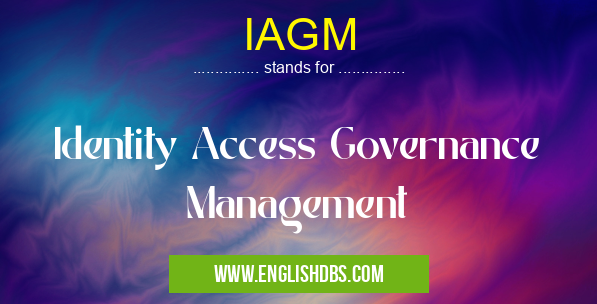What does IAGM mean in GOVERNMENTAL
IAGM (Identity Access Governance Management) is a comprehensive framework for managing the identities, access rights, and permissions of users within an organization or system. Its primary goal is to ensure that only authorized individuals have access to the resources they require while preventing unauthorized access and protecting sensitive data.

IAGM meaning in Governmental in Governmental
IAGM mostly used in an acronym Governmental in Category Governmental that means Identity Access Governance Management
Shorthand: IAGM,
Full Form: Identity Access Governance Management
For more information of "Identity Access Governance Management", see the section below.
What is IAGM?
IAGM encompasses three key components:
- Identity Management: Governs the creation, maintenance, and lifecycle of user identities, including authentication, authorization, and provisioning.
- Access Management: Controls who has access to what resources, when, and how. It includes role-based access control (RBAC), attribute-based access control (ABAC), and other authorization mechanisms.
- Governance: Establishes policies, standards, and processes to oversee and ensure compliance with IAGM principles. It includes risk assessments, audits, and continuous monitoring.
Benefits of IAGM
- Enhanced Security: Protects against unauthorized access and data breaches by strictly controlling access privileges.
- Improved Compliance: Ensures adherence to regulatory and industry standards for data protection and privacy.
- Increased Efficiency: Automates and streamlines user provisioning and access management, reducing administrative overhead.
- Reduced Risk: Identifies and mitigates potential security risks by regularly reviewing and auditing access rights.
- Enhanced User Experience: Provides a seamless and secure experience for users by simplifying access to authorized resources.
Essential Questions and Answers on Identity Access Governance Management in "GOVERNMENTAL»GOVERNMENTAL"
What is IAGM (Identity Access Governance Management)?
IAGM is a framework of policies and processes that ensure appropriate access to resources within an organization. It aims to balance security requirements with the need for user productivity.
Why is IAGM important?
IAGM helps organizations improve security by preventing unauthorized access to data and systems. It also enhances efficiency by streamlining access management processes and reducing the risk of human error.
What are the key components of IAGM?
IAGM typically includes the following components: identity management, access management, governance, and monitoring. Identity management refers to the process of creating and managing user accounts. Access management involves setting permissions and roles to control access to resources. Governance establishes policies and procedures for managing access. Monitoring ensures that access is used appropriately and regulations are adhered to.
What are the benefits of implementing IAGM?
Implementing IAGM can provide several benefits, including:
- Enhanced security
- Improved efficiency
- Reduced risk of data breaches
- Compliance with regulations
- Better user experience
What are some common challenges in implementing IAGM?
Some common challenges include:
- Managing user lifecycle and access requests effectively
- Balancing security with user productivity
- Ensuring that policies are aligned with business needs
- Keeping up with evolving regulatory requirements
What are the best practices for IAGM?
Best practices for IAGM include:
- Establishing clear policies and procedures
- Using automation to streamline processes
- Implementing multi-factor authentication
- Regularly reviewing and auditing access
- Providing training and awareness for users
Final Words: IAGM is an essential component of a comprehensive security strategy for organizations of all sizes. By implementing IAGM principles, organizations can safeguard their data, comply with regulatory requirements, and empower their users with secure and efficient access to the resources they need.
